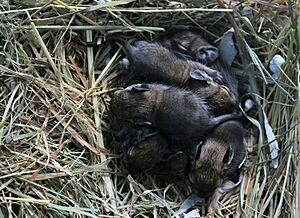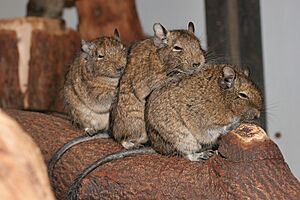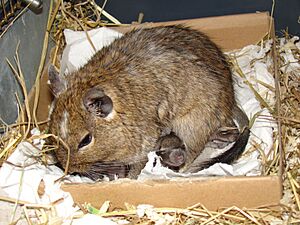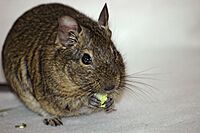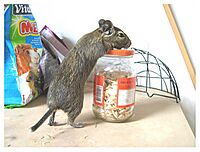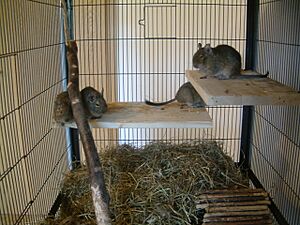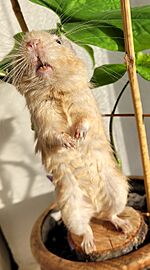Common degu facts for kids
Quick facts for kids Common degu |
|
|---|---|
 |
|
| At Heidelberg Zoo, Germany | |
| Conservation status | |
| Scientific classification | |
| Genus: |
Octodon
|
| Species: |
degus
|
| Synonyms | |
|
Sciurus degus Molina, 1782 |
|
The common degu (Octodon degus; /ˈdeɪɡuː/) is a small rodent that lives only in the Chilean matorral ecoregion of central Chile. It's a type of rodent called a hystricomorph, which includes animals like chinchillas and guinea pigs. The word degu comes from the Mapudungun language of Chile. It means 'mouse' or 'rat'.
People sometimes keep degus as pets. They are bigger than a golden hamster but smaller than a fancy rat. However, in some places, it's not allowed to own them.
Contents
What Does a Degu Look Like?
The common degu is a small animal. Its body is about 25.0 to 31.0 cm (9.8–12.2 in) long. It weighs between 170 to 400 g (6.0 to 14.1 oz). Degus have yellow-brown fur on their backs. Their bellies are creamy-yellow. They have yellow fur around their eyes. A lighter band of fur is around their necks.
Degus have a long, thin tail. The tip of the tail is black and bushy. Their ears are dark and have little fur. Their toes are pale grey. The fifth toe on their front feet is small. It has a nail instead of a claw. Their back feet have stiff bristles. The teeth in their cheeks look like the number eight. This is why their genus name, Octodon, means "eight tooth".
How Degus Live Together
Common degus are very social animals. They live in burrows underground. They dig these burrows together. This way, they can make bigger and better homes. When they dig, they work as a team. Female degus in the same group often share a nest. They even help nurse each other's babies.
Degus spend a lot of time above ground. They look for food there. When more degus are together, they are better at spotting predators. This means each degu spends less time watching for danger.
Degu Communication
Degus have many ways to talk to each other. They make up to 15 different sounds. Young degus need to hear their mother's calls. This helps their brains develop correctly. They also use their urine to mark their territory. Other degus react to these scent marks.
Degu Families
Common degus breed at certain times of the year. In the wild, they start breeding in the Chilean autumn. Babies are born in early to mid-spring. Female degus are pregnant for about 90 days. This is a long time compared to many other rodents. They usually have about six babies. Sometimes they have one or two, or up to twelve.
Degu babies are born ready for the world. They have fur and their eyes are open. They can hear and see right away. Unlike many other rodents, male degus also help raise their babies. They protect them until they are old enough to leave the family.
Seeing the World in UV Light
Common degus are active during the day. This is called being diurnal. They have good eyesight. Their eyes can see green light. They can also see ultraviolet (UV) light. Humans cannot see UV light. Scientists think this UV vision helps them socially. Their belly fur and their urine reflect a lot of UV light.
What Do Degus Eat?
Common degus are plant-eaters, also known as herbivores. In the wild, they eat grasses. They also munch on leaves from bushes. Sometimes they eat seeds too. For much of the year, their food is dry. So, degus are built to eat a lot of tough, fibrous plants.
Like rabbits, degus sometimes eat their own droppings. This is called coprophagia. It helps them get more nutrients from their food. It also keeps their gut healthy when food is scarce. Even though they are active during the day, they stay in their burrows during the hottest part of summer. They come out to find food in the mornings and evenings.
Degus and Sugar
A very important thing about degus is that they cannot handle sugar well. Degus have a different kind of insulin. Insulin is a hormone that controls blood sugar. Because of this, degus can easily get diabetes mellitus if they eat too much sugar. This is probably because there isn't much sugar in their natural home. If you have a pet degu, always check their food. Make sure it doesn't have sugary things like molasses, honey, or glucose syrup.
Degus in Science
Scientists study common degus for many reasons. Their special way of handling sugar and diabetes is one reason. But they are also studied for other interesting things.
Scientists in Japan studied how degus use tools. Degus have good eye-and-paw coordination. They learned to use a tiny rake to get seeds that were out of reach. Degus have also been seen stacking objects from biggest to smallest. These behaviors were first seen in apes and birds. It was new to see them in other animals.
Another area of study is how degus tell time. This is called their circadian rhythm. Degus can be active during the day or night. This depends on their environment. This makes them unique for studying how brains tell time. Degus can use clues like temperature. They also use levels of melatonin and even scents from other degus to adjust their daily rhythms.
Degus are also helpful for studying development and aging. Research shows that separating baby degus from their mothers can cause problems later. These problems are similar to ADHD in humans. Older degus have brain changes like those seen in humans with Alzheimer's disease. This was the first time this was seen in a wild rodent.
Degus as Pets
After being studied by scientists, degus became popular pets. They are good pets because they are active during the day. They have fun personalities. Their tails have fur, unlike rats or mice. They can also live a long time. Some degus live up to 13 years if they are cared for perfectly. However, most pet degus live about six to eight years.
One challenge with degus as pets is that they love to chew. Their front teeth and back teeth grow all the time. So, they need to chew to keep their teeth healthy. Because of this, you cannot keep them in plastic cages. A metal cage with many levels is best. It should be like a cage made for rats. Make sure the levels are lined with grass mats or soft fabric. This prevents a foot problem called bumblefoot.
Untamed degus might bite, like some other small pets. But they are smart and easy to tame. Handle them gently and offer them food often. Never try to catch a degu by its tail. The skin and fur at the end of their tail can easily come off. This helps them escape predators in the wild. But it hurts them, and the tail will not grow back. If this happens, degus will chew off the damaged part. This helps prevent infection.
Degus often "groom" their human owners. They do this with a gentle nibbling action. They easily bond with people who spend time with them. Degus need regular sand baths. This is like how chinchillas need dust baths. Sand baths keep their fur healthy and clean. Chinchilla sand is perfect for this. They should have access to these baths a few times a week for about half an hour. But bathing them daily can make their fur dirty.
Where Degus Are Not Allowed
Some places see common degus as a possible invasive species. This means they could cause harm if they escape into the wild. So, it is against the law to own them as pets in some areas.
In the United States, you cannot own degus in California, Utah, Georgia, Connecticut, and Alaska.
Images for kids
See also
- Communal burrow
- In Spanish: Degú para niños




